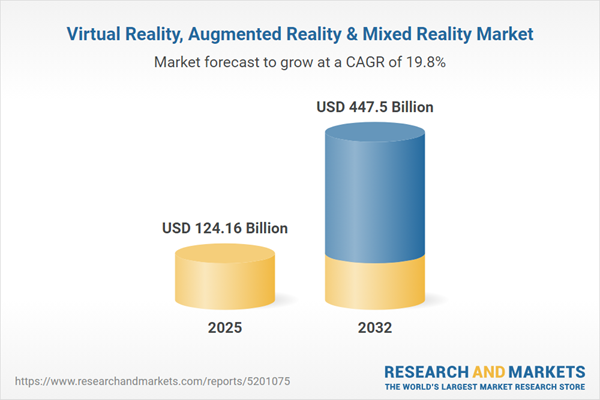Speak directly to the analyst to clarify any post sales queries you may have.
Immersive technology is reshaping enterprise operations by accelerating digital transformation, bolstering adaptability, and supporting strategic growth. Senior decision-makers are deploying solutions like virtual reality, augmented reality, and mixed reality to better address evolving customer needs and navigate shifting market trends.
Market Snapshot: Virtual Reality, Augmented Reality & Mixed Reality Market
The immersive technology market is advancing steadily as adoption intensifies across diverse industries. Enterprises in manufacturing, healthcare, and education are incorporating immersive platforms to help develop workforce skills, maximize productivity, and maintain their competitive positions. Advances in both hardware and software are not only simplifying complex processes but also equipping organizations to meet emerging operational challenges efficiently. Integrating these technologies allows companies to uncover new growth channels and enhance agility. As more businesses embrace immersive solutions, their ability to adapt and engage in digital markets increases, securing their relevance in a continuously evolving landscape.
Scope & Segmentation of the Immersive Technology Market
- Technology Types: Includes location-based augmented reality, marker-based and markerless AR systems, projection-based experiences, immersive and non-immersive virtual reality, and mixed reality platforms that blend the digital and physical work environments.
- Component Categories: Covers hardware such as sensors, displays, projectors, cameras, accessories, essential tracking systems, plus software and services including consulting, integration, deployment, ongoing maintenance, and content management for end-to-end solutions.
- Device Types: Encompasses handheld hardware, head-mounted displays, and heads-up displays designed to support onsite workflows, remote teamwork, and immersive collaborative experiences.
- Device Categories: Features both wired and wireless solutions to support flexible deployments—ideal for mobile or stationed applications within expansive enterprise environments.
- Applications: Spans use in education, workforce skills enhancement, entertainment, advanced industrial operations, healthcare delivery, real estate marketing, and innovative retail or e-commerce strategies, enabling specific organizational productivity gains.
- End-Users: Targets commercial entities, public sector organizations, and consumers who leverage immersive technology for efficiency improvements, upskilling, and stakeholder engagement.
- Regions Covered: Analyzes the Americas, Europe, Middle East, Africa, and Asia-Pacific, reflecting regulatory, manufacturing, and operational distinctions that influence enterprise strategies and compliance.
- Leading Companies Assessed: Reviews prominent companies including Apple Inc., Baidu, Carl Zeiss AG, CitrusBits Inc., Goertek Inc., Google LLC, HiSilicon, HP Inc., HTC Corporation, Immersion Corporation, Lenovo, Magic Leap, Meta Platforms, Microsoft, Niantic, Nvidia, PICO Immersive, Qualcomm Technologies, Samsung Electronics, Seiko Epson, Sharp Corporation, Snap Inc., Sony Group, Ultraleap Limited, Unity Software, Valve Corporation, VR Owl BV, Owl VR Solutions, Vrgineers, Vuzix Corporation, and Xiaomi.
Key Takeaways for Senior Decision-Makers
- Implementing immersive technology enhances workforce flexibility and enables broader transformation initiatives within complex organizations.
- Collaboration among hardware, software, and connectivity partners is crucial for the seamless deployment of immersive solutions across multiple sectors.
- Distinct market dynamics across North America, EMEA, and Asia-Pacific require tailored strategies. North America drives software innovation, EMEA solutions reflect evolving regulations, and Asia-Pacific demonstrates manufacturing strength.
- Diversified vendor and production networks give enterprises the resilience needed to navigate regulatory changes and varying market requirements with agility.
- Strategic investments in artificial intelligence and tailored development resources foster long-term adoption and support continuous innovation around immersive platforms.
Tariff Impact on Adoption and Cost Dynamics
Recent U.S. tariff adjustments have prompted manufacturers to diversify sourcing and broaden production locations, improving enterprise access to immersive solutions. In parallel, software providers now offer adaptable pricing models and products tailored by region, enabling organizations to better control costs and adhere to local regulations. These responses are enhancing business agility as global trade and regulatory environments shift.
Methodology & Data Sources
This report combines rigorous secondary research, targeted expert interviews, and structured trend reviews. Integrated quantitative and qualitative insights undergo thorough validation to deliver reliable strategic guidance for immersive technology investment decisions.
Why This Report Matters
- Enables actionable insights for immersive technology adoption and alignment with digital transformation objectives.
- Improves risk management and compliance, allowing proactive resource allocation and response to evolving challenges.
- Equips organizations with the strategic foundation for enhanced resilience and innovation as digital business models progress.
Conclusion
This analysis supports senior leaders with clear strategic direction for immersive technology investments, ensuring continued organizational adaptability and relevance amid rapidly changing markets.
Additional Product Information:
- Purchase of this report includes 1 year online access with quarterly updates.
- This report can be updated on request. Please contact our Customer Experience team using the Ask a Question widget on our website.
Table of Contents
3. Executive Summary
4. Market Overview
7. Cumulative Impact of Artificial Intelligence 2025
Companies Mentioned
The companies profiled in this Virtual Reality, Augmented Reality & Mixed Reality market report include:- Apple Inc.
- Baidu, Inc.
- Carl Zeiss AG
- CitrusBits Inc.
- Goertek Inc.
- Google LLC by Alphabet Inc.
- HiSilicon (Shanghai) Technologies Co., Ltd.
- HP Inc.
- HTC Corporation
- Immersion Corporation
- Lenovo Group Limited
- Magic Leap, Inc.
- Meta Platforms, Inc.
- Microsoft Corporation
- Niantic, Inc.
- Nvidia Corporation
- PICO Immersive Pte.ltd.
- Qualcomm Technologies, Inc.
- Samsung Electronics Co., Ltd.
- Seiko Epson Corporation
- Sharp Corporation
- Snap Inc.
- Sony Group Corporation
- Ultraleap Limited
- Unity Software Inc.
- Valve Corporation
- VR Owl BV and Owl VR Solutions GmbH
- Vrgineers, Inc.
- Vuzix Corporation
- Xiaomi Corporation
Table Information
| Report Attribute | Details |
|---|---|
| No. of Pages | 187 |
| Published | November 2025 |
| Forecast Period | 2025 - 2032 |
| Estimated Market Value ( USD | $ 124.16 Billion |
| Forecasted Market Value ( USD | $ 447.5 Billion |
| Compound Annual Growth Rate | 19.7% |
| Regions Covered | Global |
| No. of Companies Mentioned | 30 |









